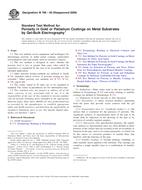We need your consent to use the individual data so that you can see information about your interests, among other things. Click "OK" to give your consent.
ASTM B533-85(2013)
Standard Test Method for Peel Strength of Metal Electroplated Plastics
STANDARD published on 1.12.2013
The information about the standard:
Designation standards: ASTM B533-85(2013)
Note: WITHDRAWN
Publication date standards: 1.12.2013
SKU: NS-7057
The number of pages: 4
Approximate weight : 12 g (0.03 lbs)
Country: American technical standard
Category: Technical standards ASTM
The category - similar standards:
Annotation of standard text ASTM B533-85(2013) :
Keywords:
electroplated plastic, peel strength test, ICS Number Code 25.220.40 (Metallic coatings)
Additional information
| Significance and Use | ||
|
4.1 The force required to separate a metallic coating from its plastic substrate is determined by the interaction of several factors: the generic type and quality of the plastic molding compound, the molding process, the process used to prepare the substrate for electroplating, and the thickness and mechanical properties of the metallic coating. By holding all others constant, the effect on the peel strength by a change in any one of the above listed factors may be noted. Routine use of the test in a production operation can detect changes in any of the above listed factors. 4.2 The peel test values do not directly correlate to the adhesion of metallic coatings on the actual product. 4.3 When the peel test is used to monitor the coating process, a large number of plaques should be molded at one time from a same batch of molding compound used in the production moldings to minimize the effects on the measurements of variations in the plastic and the molding process. |
||
| 1. Scope | ||
|
1.1 This test method gives two procedures for measuring the force required to peel a metallic coating from a plastic substrate.2 One procedure (Procedure A) utilizes a universal testing machine and yields reproducible measurements that can be used in research and development, in quality control and product acceptance, in the description of material and process characteristics, and in communications. The other procedure (Procedure B) utilizes an indicating force instrument that is less accurate and that is sensitive to operator technique. It is suitable for process control use. 1.2 The tests are performed on standard molded plaques. This method does not cover the testing of production electroplated parts. 1.3 The tests do not necessarily measure the adhesion of a metallic coating to a plastic substrate because in properly prepared test specimens, separation usually occurs in the plastic just beneath the coating-substrate interface rather than at the interface. It does, however, reflect the degree that the process is controlled. 1.4 This standard does not purport to address all of the safety concerns, if any, associated with its use. It is the responsibility of the user of this standard to establish appropriate safety and health practices and determine the applicability of regulatory limitations prior to use. |
||
| 2. Referenced Documents | ||
|
Similar standards:
Historical
1.12.2013
Historical
1.8.2008
Historical
1.11.2010
Historical
1.10.2009
Historical
1.10.2009
Historical
1.12.2013
We recommend:
Updating of laws
Do you want to be sure about the validity of used regulations?
We offer you a solution so that you could use valid and updated legislative regulations.
Would you like to get more information? Look at this page.



 ASTM B765-03(2013)..
ASTM B765-03(2013).. ASTM B766-86(2008)..
ASTM B766-86(2008).. ASTM B767-88(2010)..
ASTM B767-88(2010).. ASTM B798-95(2009)..
ASTM B798-95(2009).. ASTM B799-95(2009)..
ASTM B799-95(2009).. ASTM B809-95(2013)..
ASTM B809-95(2013)..
 Cookies
Cookies
